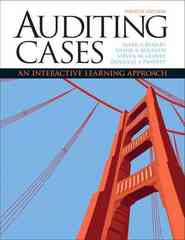Analytical procedures can be powerful tools in conducting an audit. They help the auditor understand a clients
Question:
Analytical procedures can be powerful tools in conducting an audit. They help the auditor understand a client’s business and are useful in identifying potential risks and problem areas requiring greater substantive audit attention. If formulated carefully, they allow the auditor to arrive at a precise expectation of what an account balance ought to be; the balance per the client’s books is then compared against this expectation. Thus, “analytics” can sometimes provide a source of inexpensive and powerful substantive evidence that complements or even replaces time-consuming detailed testing. Finally, analytical procedures are useful in helping the auditor assess whether a client faces a going-concern issue and whether a client’s financial statements “make sense” after required audit adjustments are made.
The three general uses of analytical procedures listed above correspond to the three stages of an audit in which they are typically used—planning, evidence gathering, and final review. Auditing Standards (AU) No. 329, Analytical Procedures, provides guidance to auditors on how and when to use analytical procedures. AU No. 329 requires auditors to use analytics in the planning and final review stages, and encourages—but does not require—the use of analytics in the substantive evidence-gathering stage of the audit.
This case addresses the use of analytical procedures in the planning stage of the audit. During planning, analytics help the auditor gain an overall understanding of the client and its business environment. They also help the auditor plan the evidence that will be gathered in various audit areas by helping the auditor identify potential risks and problem areas requiring more extensive substantive testing.
BACKGROUND You are a senior auditor assigned to the Laramie Wire Manufacturing audit. This is the first year your firm has conducted the audit for this particular client. In fact, although Laramie has previously engaged accountants to perform limited review services for the purpose of obtaining bank loans, this is the first year Laramie has contracted for a full-scale audit of its financial statements. The company is planning an initial public offering (IPO) of its stock in the next two or three years and has hired your firm to conduct its first financial statement audit in preparation for the upcoming IPO. Laramie is a medium-sized company that buys copper rod and plastic materials used to make insulated copper wiring. Laramie operates out of a single building complex totaling 500,000 square feet, which includes office space (3%), production area (57%), shipping and receiving (15%), and finished goods and raw materials inventory warehousing (25%). Laramie supplies insulated copper wiring in the northeastern part of the United States. The company has a good reputation for quality products and has had a good working relationship with its outside accountants over the past 10 years. You have been assigned responsibility for auditing Laramie’s inventories. You are in the planning stages of the audit, and you are preparing to conduct some analytical procedures to help you identify areas that may represent heightened risk and that thus may require further attention.
Your staff assistant assembled information relating to inventories and other items, including a brief description of Laramie’s production and inventory areas. Because your assistant is new, he is not very good about weeding out irrelevant information, so you may not need to use every piece of information he has provided. The information is listed below.........
REQUIRED [1] Perform analytical procedures to help you identify relatively risky areas that indicate the need for further attention during the audit, if any.
[2] Focus specifically on each of the following balance-related management assertions for the inventory account: existence, completeness, valuation, and rights and obligations. Link any risks you identified for this account in question 1 to the related management assertion. Briefly explain identified risks for the inventory account that require further attention, if any.
Step by Step Answer:

Auditing Cases An Interactive Learning Approach
ISBN: 978-0132423502
4th Edition
Authors: Steven M Glover, Douglas F Prawitt





